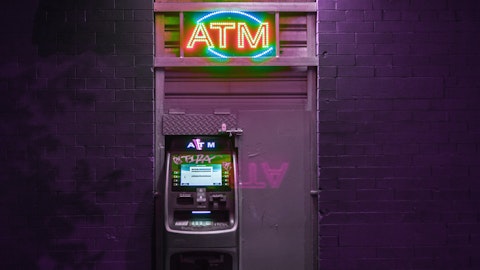John Corbett: Yes. borrower demand is up, Michael. We said in our prepared remarks, the pipeline has really shrunk after Silicon Valley last spring. But in November, they really started picking up. So our pipelines are up about 33% since November, a little over $1 billion. Most of it is C&I. It is pretty broad based, it’s not CRE related. When you think about the Southeast, clearly, there’s the net migration story, but there is a lot of — to the manufacturing story in the Southeast. We have opened seven new auto plants in the last three years for electric vehicles and batteries and every one of those plants is thousands of new jobs. Generally speaking, there is fewer supply chain issues than there were before. The ports are not backed up in Savannah and Charleston like they were.
Container shipping cost has come back down to $2,500 a container. But labor is still tight. There is some slack maybe in white collar jobs, but there is a considerable labor shortage still in construction and hospitality. So overall, it feels like the Southeast is going to continue to grow and be able to work its way through these interest rate increases.
Michael Rose: Very helpful. Maybe just finally for me, it looks like you guys repurchased a little bit of common stock again. This quarter, your capital levels are pretty solid. Just any thoughts there just given where the stock is trading? I understand your premium to most peers. But just wanted to get a sense for what the thought processes are around the buyback. Thanks.
Will Matthews: Yes, Michael, it’s Will. I think our attitude remains one of a being opportunistic and being — having the ability and flexibility to use that buyback authorization, particularly if we see weakness when a window is open, I think we also though value the optionality that we think we have from a strong capital and strong reserve position to allow us to grow organically, to execute other things with that capital. So I think sitting here today, we like the flexibility of being able to do something with it, but we also like the strong capital position we are in. And we think accreting capital probably continues to make sense for [that] (ph).
Michael Rose : Understood. Thanks for taking my questions.
Operator: And we will take our next question from Brandon King with Truist Securities. Your line is open.
Brandon King: Hi, good morning. So I wanted to follow up on the comments around the acceleration in deposit costs, I guess some acceleration in the quarter. Could you kind of describe where you saw that as far as what type of accounts, the type of customers, et cetera?
Steven Young: Hi, Brandon, it’s Steve. I would call it a deceleration in deposit costs. Last quarter, I think — let me think through — I think in the second quarter, it shows it on Page 17, I think. But in the second quarter — excuse me, the third quarter our deposit costs were up 33 basis points. I think in the fourth quarter, they were up 16 basis points. And then the fourth — in the first quarter, they were up 14 basis points. So it’s been coming down. And I think in the — as we look at the first quarter, there is a bit of a remix and some seasonality. I guess, as I think about the deposit base, sort of some of the pluses and minuses happening in the first quarter. So the minuses first would be just around public funds.
Typically, there is some seasonality. Those typically have a little bit higher deposit cost and those ran down a couple of hundred million, which is typical in the first quarter. On the positive side, we had a really good growth and have over the last couple of quarters in our homeowners association business over $100 million, a team led by Jarrod Hurd. And that team brings in a little bit lower cost of deposits or significantly lower cost of deposits, a lot of cash management business. So I kind of look at it as – there is a bit of a remix within that whole deposit piece, but I wouldn’t — certainly didn’t call it accelerating, I would call it, decelerating as a general rule.
Brandon King: Okay. I was time referring to kind of, I guess, the pickup after the CPR reports that you alluded to earlier.
Steven Young: I am sorry. No, if I may have been misunderstood. I think what I was saying was that we did see during the quarter, a deceleration of deposit costs but it’s hard to know, as we continue to see these other [CPR reports] (ph) as we think in the second, third, fourth quarter, how that plays out. But what we actually see on the ground is a little bit of deceleration and that’s why our guide is kind of a 5 basis points to 10 basis points of deposit costs versus 14 last quarter. But if we stay at a higher for longer, how will that look in the third or fourth quarter. I don’t know, that we know for sure.
Brandon King: Okay. Okay. And I guess in regards to credit, I recognize the movement in [special mention] is substandard but not really reflecting lost content. But in your view, how do you see potential credit loss trajectory if kind of rates stay here for a while and even if long-term yields continue to rise higher?
John Corbett: We’re trying to forecast and ask our credit team that same question and we are trying to understand where the loss content might come from in a higher for longer. So we had meeting other day and Steve asked our Chief Credit Officer Dan, not the magnitude of losses, but where would those losses come from the cycle, and I thought his answer was insightful. He thought that 40% of it would probably be in the C&I portfolio. He thought that 40% of whatever the potential losses would be would probably be in office. And then the other 20% would be in smaller SBA and consumer kind of losses. So interestingly, he saw no loss content or very little to no loss content in multi-family, retail or industrial. So I thought that was an enlightening answer of kind of what his crystal ball was but you can’t judge the magnitude of this. Right now, it doesn’t look like there is much magnitude at all. But that’s where he sees potential loss content.
Brandon King: Yes. And just curious, what sort of assumptions was he making with those comments as far as kind of [get there] (ph)?
John Corbett: That would be probably in a — I guess, higher for longer means basically static kind of rate curve. And if — Brandon, it’s the five-year treasury, and it is kind of assuming the five-year treasury stays in that 5% or less range, if the five-year treasury moves to 6%, 7%, I think the industry is headed for more noticeable losses across the board, particularly CRE.
Brandon King: Okay, very helpful. Thanks for taking my question.
John Corbett: You bet.
Operator: And we will take our next question from Gary Tenner with D.A. Davidson. Your line is open.
Gary Tenner: Hi guys good morning. I just wanted to ask a follow-up on the fee income side of things, particularly in mortgage and correspondent banking. Given that you are at the top end of the range of this quarter, what are you seeing in terms of maybe early second quarter activity in both areas? And is the correspondent piece — is the pushout of lower rates? Does that just keep the variation margin, interest piece higher a little bit deeper into the year? Is that the biggest delta in terms of that line item?
Steven Young: Yes, Gary. That is right. I think as we think about correspondent, we are sort of near the bottom on sort of the gross income, we think somewhere in that $14 million to $18 million range over the next few quarters. But you are right, with the move up in long-term interest rates, the variation margin gets to be a little higher. So that moves — move that — I’ll call it, contra income account up a few million dollars a quarter. So it’s — and then we think as we think about mortgage, the second quarter should be a good quarter, but it is a little too early to tell. We definitely did have a spike up in the first quarter. So as we think about the entire picture and think about where non-interest income to average assets, we just really think with all the things we are looking at today, we think it is probably in that 55 basis points to 60 basis points range until we get some footing on the — on whether we get rate cuts, when we get them.
The fixed income business, of course right now with higher rates is a much challenging business. And as we move our SBA team up in Houston that we just recruited over, that will help that. But it takes a few quarters to get that up and moving, but that really mostly a 2025 event.
Gary Tenner: Okay. Thank you for that. And then just one question on the construction piece. Obviously, not much of new commitments, I’d assume in that business right now. Hence, the kind of rolling over of the period imbalances. How much kind of planned exits are there on the construction side as you look over the remainder of the year?
Steven Young: Yes. You are right, Gary. I think our construction development portfolio decreased significantly. It was down by like $500 million roughly in the quarter. And that was some of these projects just coming to completion. But Will, as far as the unfunded piece that’s left to construction, do you have that number?
Will Matthews: Yes. Let’s see. Unfunded piece is around $2 billion. And the biggest piece of that would be — most of the largest property type within that. And then the second would be the owner constructed single-family residential. So a loan to Gary Tenner to build his custom house where he’s the borrower, not the builder. That would be the second biggest. And just kind of a bunch of different categories.
John Corbett: But the ratio of construction to the capital, Gary dropped pretty significantly during the quarter, below 50% and we really don’t see in the near term that moving up even with some of those fundings. We sort of think there is payoffs along the way and it kind of drift sideways roughly from here.
Will Matthews: We’ve not been refilling that bucket, and that’s why you’ve seen that number come down as it has the last couple of quarters, as well as the reserves were [unfunded supportingly] (ph), as well as those amounts come down.
Gary Tenner: Okay. But you are saying — it sounds like you’re saying that funding of existing commitments sort of offsets exits for the remainder of the year versus another step down?
Will Matthews: That’s what it looks like right now, yes.
Gary Tenner: Thank you.
Operator: [Operator Instructions] And we will take our next question from Dave Bishop with Hovde Group. Your line is open.
Dave Bishop: Hi, good morning. A quick question during the preamble. I think it was Will noted maybe the loan repricing on the fixed rate side could provide a tailwind. Just to remind us what the — I guess, the dollar volume of repricing looks like over the next few quarters and what they might see pricing to and from? Thanks.



